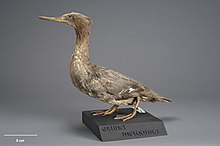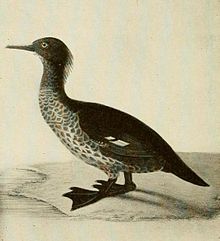The New Zealand merganser (Mergus australis) (Māori: Miuweka),[3] also known as Auckland merganser or Auckland Islands merganser, was a typical merganser which is now extinct.
| New Zealand merganser Temporal range: Late Holocene | |
|---|---|
 | |
| Stuffed specimen from 1902 | |
| Scientific classification | |
| Domain: | Eukaryota |
| Kingdom: | Animalia |
| Phylum: | Chordata |
| Class: | Aves |
| Order: | Anseriformes |
| Family: | Anatidae |
| Genus: | Mergus |
| Species: | †M. australis |
| Binomial name | |
| †Mergus australis | |



Description
This duck was similar in size to the red-breasted merganser (Mergus serrator). The adult male had a dark reddish-brown head, crest and neck, with bluish black mantle and tail and slate grey wings.[4] The female was slightly smaller with a shorter crest.
History
This bird's Māori name was miuweka.[2] It was first collected when a French expedition led by the explorer Jules Dumont d'Urville on the ships L'Astrolabe and La Zelee visited the Auckland Islands in 1840. Its decline was caused by a combination of hunting and predation by introduced mammals.[5] The bird was not flightless, but rather hard to flush; it preferred to hide between rocks when pursued. The last sighting was of a pair shot on January 9, 1902. It was not found in a 1909 search, and a thorough 1972/1973 exploration of possible habitat concluded that it was long extinct.[6]
Subsequent fossil discoveries suggest that this merganser was previously resident in the South Island, and on Stewart Island/Rakiura in New Zealand. Fossils of a subspecies or closely related species have also been found on the Chatham Islands. There exists a short remark mentioning "a merganser" found on Campbell Island,[7] but this may just as well refer to the semi-marine Campbell teal which is otherwise missing in McCormick's notes: he only mentions the Pacific black duck ("a New Zealand species of duck").[8]



